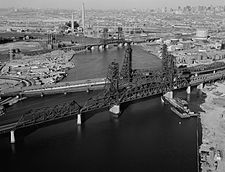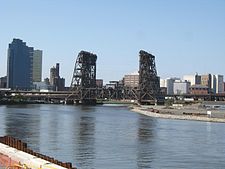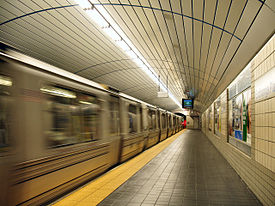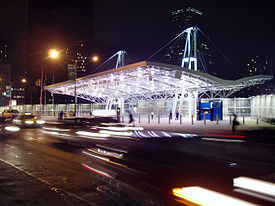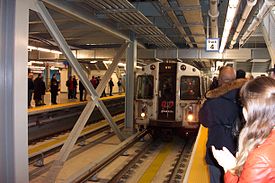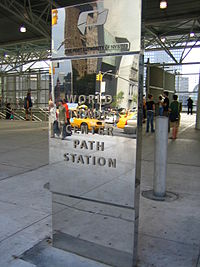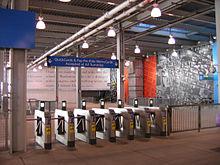- Port Authority Trans-Hudson
-
Coordinates: 40°43′52.74″N 74°3′33.59″W / 40.7313167°N 74.0593306°W
Port Authority Trans-Hudson 

A PATH train of PA-5 cars crossing the Passaic River.Info Owner Port Authority of New York and New Jersey Locale Newark / Hudson County, New Jersey and Manhattan, New York Transit type Rapid transit Number of lines 4 Number of stations 13 Daily ridership 246,000 (2007) Operation Began operation 1908 Operator(s) Port Authority Trans-Hudson Technical Track gauge 4 ft 8 1⁄2 in (1,435 mm) (standard gauge) System map Legend


33rd Street 


28th Street (Closed) 


23rd Street 


19th Street (Closed) 


14th Street 


9th Street 


Christopher Street 


World Trade Center Hudson River / NJ/NY Border 


Exchange Place 


Newport 


Grove Street 


Hoboken Terminal 


Journal Square 


Hackensack River via PATH Lift Bridge 


Manhattan Transfer (Closed) 


Harrison 


Passaic River via Dock Bridge 


Newark PATH, derived from Port Authority Trans-Hudson, is a rapid transit railroad linking Manhattan, New York City with Newark, Harrison, Hoboken and Jersey City in metropolitan northern New Jersey. It is operated by the Port Authority of New York and New Jersey, a bi-state agency controlled by the governors of the two states.
While some PATH stations are adjacent or connected to New York City Subway, Newark Light Rail, Hudson-Bergen Light Rail, and New Jersey Transit stations, there are no free transfers between these different, independently run transit systems; however, PATH does accept the same pay-per-ride MetroCard used by the New York City Subway. PATH trains run 24 hours a day.
PATH has a route length of 13.8 miles (22.2 km), not including any route overlap.[1]
PATH trains use tunnels only in Manhattan, Hoboken and downtown Jersey City. The tracks cross the Hudson River through century-old cast iron tubes that rest on the river bottom under a thin layer of silt. PATH's route from Grove Street in Jersey City west to Newark runs in open cuts, at grade level, and on elevated track.
As of the 4th quarter of 2007, PATH had an average weekday ridership of 246,000.[2]
Contents
History
The history of PATH, originally known as the Hudson and Manhattan Railroad, predates the first underground line of the New York City Subway (the IRT). Although the railroad was first planned in 1874, existing technologies could not safely tunnel under the Hudson River. Construction began on the existing tunnels in 1890, but stopped shortly thereafter when funding ran out. Construction did not resume until 1900 under the direction of William Gibbs McAdoo, an ambitious young lawyer who had moved to New York from Chattanooga, Tennessee. McAdoo would later become president of what would, for many years, be known as the H&M, Hudson Tubes or McAdoo Tunnels.[3]
Construction of the tunnels
The first tunnel (the northernmost of the uptown pair) was originally built without an excavation shield or iron construction because the chief engineer of the time, Dewitt Haskin, believed that the river silt was strong enough to maintain the tunnel's form (with the help of compressed air) until a 2½ foot (76 cm) thick brick lining could be constructed. Haskins' plan was to excavate the tunnel, then fill it with compressed air to expel the water and to hold the iron plate lining in place. They succeeded in building the tunnel out by approximately 1,200 feet (366 m) from Jersey City until a series of blowouts — including a particularly serious one in 1880 that took the lives of 20 workers — ended the project.[3]
When the New York and Jersey Tunnel Company resumed construction on the tunnels in 1902, they employed a different method of tunneling using tubular cast iron plating. An enormous mechanical shield was pushed through the silt at the bottom of the river. The displaced mud would then be placed into a chamber, where it would later be shoveled into small cars that hauled it to the surface.[citation needed] In some cases, the silt would be baked with kerosene torches to facilitate easier removal of the mud. The southernmost tunnel of the uptown pair, as well as the downtown tunnels, were all constructed using the tubular cast iron method.
The tunnels are separate for each track, which enables a better ventilation by so-called piston effect. When a train passes through the tunnel it pushes out the air in front of it toward the closest ventilation shaft in front, and "sucks-in" the air to the tunnel from the closest ventilation shaft behind it.
The tunnels in Manhattan, on the other hand, employed cut and cover construction methods.
Hudson and Manhattan Railroad years
The first trains ran in 1907 and revenue service started between Hoboken and 19th Street at midnight on February 26, 1908, after President Theodore Roosevelt pressed a button at the White House that turned on the electric lines in the uptown tubes.[4] On July 19, 1909, service began between the Hudson Terminal in Lower Manhattan and Jersey City, through the downtown tubes located about 1¼ miles (2 km) south of the first pair. After the completion of the uptown Manhattan extension to 33rd Street and the westward extension to the now-defunct Manhattan Transfer and Park Place Newark terminus in 1911, the Hudson and Manhattan Railroad was considered to be complete. The cost of the entire project was estimated at between $55 and $60 million, equal to more than $1 billion in present-day dollars[5][6]
Originally, the Hudson Tubes were designed to link three of the major railroad terminals on the Hudson River in New Jersey — the Lackawanna in Hoboken, the Erie and PRR in Jersey City — with New York City. While it still provides a connection to train stations in Hoboken and Newark, the commuter train stations at Erie (now Pavonia-Newport) and Exchange Place (the PRR station) have since closed down. Towards the end of the 20th century the old rail yards at Pavonia and Exchange Place were replaced with large-scale office, residential, and retail developments.
The original plan included an agreement between H&M and the Pennsylvania Railroad whereby PRR traffic headed for Lower Manhattan would transfer at Manhattan Transfer to the Hudson Tubes, and H&M would operate all traffic — ferry, train, or tube — between Lower Manhattan and Newark. The Tubes would also take over operation of the Jersey City Pennsylvania Railroad Harborside Terminal station at Exchange Place, when the new Pennsylvania Station in midtown Manhattan were to open, which would have its own tunnel under the Hudson River.[citation needed] Penn Station in Manhattan did open some ten years later,[citation needed] but the plans had changed;[citation needed] the PRR maintained operation of its Jersey City Station and they also maintained their ferries between Exchange Place and Lower Manhattan. Additionally, the route between Journal Square (then Summit Avenue) and Newark became a joint operation of the H&M and PRR.
There were early negotiations for Pennsylvania Station to also shared by the two railroads.[7] Attempts to extend the Tubes to Astor Place and Grand Central Terminal failed, even after some construction began on the extension. There was also a plan to build an extension from the curve west of Hoboken Terminal to where Secaucus Junction is now, and a plan for a north-south connection from the 33rd Street Station south on Broadway to Union Square and then a new alignment to Hudson Terminal.
The opening of the Holland Tunnel in 1927, coupled with the Depression that began shortly after, marked the decline of the Hudson and Manhattan Railroad. Later, the construction of the Lincoln Tunnel and the George Washington Bridge further enticed people away from the railroad. All of these tunnels were intended to increase the flow of auto-traffic, providing an alternative to the railway.
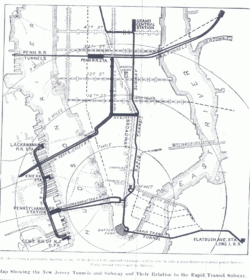 One of the original plans, with branches to the IRT Lexington Avenue Line and the Central Railroad of New Jersey terminal
One of the original plans, with branches to the IRT Lexington Avenue Line and the Central Railroad of New Jersey terminal
Early timeline
- February 25, 1908: The uptown tubes open from 19th Street to Hoboken Terminal.[4]
- June 15, 1908: The H&M is extended from 19th Street to 23rd Street.[8]
- July 19, 1909: The downtown tubes open from Hudson Terminal to Exchange Place.[9][10]
- August 2, 1909: The New Jersey-side connection opens, between Exchange Place and the junction near Hoboken Terminal.[11]
- September 6, 1910: The H&M is extended from Exchange Place west to Grove Street.[12]
- November 10, 1910: The H&M is extended from 23rd Street to 33rd Street.[13][14]
- November 27, 1910: The PRR tunnel to New York Penn Station opens.[15]
- October 1, 1911: The H&M is extended from Grove Street west to Manhattan Transfer.[16]
- November 26, 1911: The H&M opens to Park Place, Newark.[17]
- June 20, 1937: Manhattan Transfer is closed and the H&M is realigned to Newark Penn Station from the Park Place terminus a quarter mile north; the Harrison station across the Passaic River is moved several blocks south as a result. On the same day, the Newark City Subway is extended to Newark Penn Station. The upper level of the Centre Street Bridge to Park Place later became Route 158.[18]
Port Authority takeover
Promotions and other advertising proved ineffectual at slowing the financial decline. In the 1950s, H&M fell into bankruptcy, but continued to operate. It remained under bankruptcy court protection for years, a source of embarrassment. For decades, New Jersey politicians asked the Port Authority to operate the vital transit link, but Port Authority officials were reluctant to assume the money-losing operation, and New York politicians did not want extra Port Authority money spent in New Jersey.
The World Trade Center finally enabled the three parties to compromise. The Port Authority agreed to purchase and maintain the Tubes in return for the rights to build the World Trade Center on the land occupied by H&M's Hudson Terminal, which was the Lower Manhattan terminus of the Tubes.
In 1962, the Hudson and Manhattan Railroad Company ceased operation of the Hudson Tubes, and service began through the Port Authority Trans-Hudson Corporation (PATH), a subsidiary organization of the Port Authority. Upon taking over the H&M Railroad, the Port Authority spent $70 million to modernize PATH's infrastructure.[19]
During the 1980s, the PATH system experienced substantial growth in ridership, which meant the infrastructure needed expansion and rehabilitation. The Port Authority announced a plan in 1988 to upgrade the infrastructure so that stations on the Newark-WTC line could accommodate longer 8-car trains while 7-car trains could operate between Journal Square and 33rd Street.[20] In August 1990, the Port Authority put forth a $1 billion plan to renovate the PATH stations and add new rail cars.[21] To help provide revenue, the Port Authority installed video monitors in its stations that display advertising.[22] At that time, the Port Authority incurred a $135 million deficit annually, which it sought to alleviate with a fare hike to reduce the per passenger subsidy.[23] By 1992, the Port Authority had spent $900 million on infrastructure improvements, including track repairs, modernizing communications and signaling, new ventilation equipment, and they installed elevators at most stations to accommodate the disabled. A new car maintenance facility was also added in Harrison, at a cost of $225 million.[24]
On December 11, 1992, a storm caused extensive flooding in the PATH tunnels, resulting in the system being out of service for 10 days. A 2,500 to 3,000 ft section of track between Hoboken and Pavonia was flooded, as were other locations within the system. This was the longest period of disruption since a 2½ month strike in 1980.[25] When the 1993 World Trade Center bombing occurred, a section of ceiling in the PATH station collapsed and trapped dozens.[26] Nonetheless, the PATH station did not suffer any structural damage.[27] Within a week, the Port Authority was able to resume PATH service to the World Trade Center.[28]
After September 11
The World Trade Center station, which is one of PATH's two New York terminals, was destroyed on September 11, 2001 when the buildings above it collapsed. Just prior to the collapse, the station was closed and any waiting passengers that were in the station were evacuated by a train that was already inside the terminal.
With the station destroyed, service to Lower Manhattan was suspended for over two years. Exchange Place, the next station on the Newark–World Trade Center line, also had to be closed because it could not operate as a "terminal" station.[29] Instead, two uptown services (Newark–33rd Street (red) and Hoboken–33rd Street (blue)) and one intrastate New Jersey service (Hoboken-Journal Square (green)) were put into operation. Only one after-hours train was put into service, Newark–33rd Street (via Hoboken).
Restoration of service to Exchange Place
Modifications were made to a stub end tunnel (also known as the Penn Pocket, which was originally built for short turn World Trade Center to Exchange Place runs to handle PRR commuters from Harborside Terminal) to allow trains from Newark to reach the Hoboken bound tunnel and vice versa. The modifications required PATH to bore through the bedrock dividing the stub tunnel and the tunnels to and from Newark. The new Exchange Place station opened in June 2003. Because of the original alignment of the tracks, trains to/from Hoboken use separate tunnels from the Newark service.[citation needed] From Newark, trains would cross over to the Newark/Hoboken bound track just north of Exchange Place. The train would then reverse direction and go to Hoboken. From Hoboken, trains would enter on the Manhattan bound track at Exchange Place. The train would then reverse direction and use several switches west of the station to go to the Newark bound tracks before entering Grove Street.[citation needed]
Restoration of service to World Trade Center
PATH service to Lower Manhattan was restored when a $323 million temporary station opened on November 23, 2003; the inaugural train was the same one that had been used for the evacuation. The new station still contains portions of the original station but it does not have heating or air conditioning systems installed. The temporary entrance was closed on July 1, 2007 and demolished to make way for the permanent station, while the Church Street entrance opened.[30] On April 11, 2007, the Port Authority announced that it will build a new entrance to the World Trade Center PATH station on Vesey Street. The new entrance opened in March 2008, and the entrance on Church Street has since been demolished. The permanent World Trade Center PATH station construction, according to The Star-Ledger of Newark, has been awarded to a joint-venture of Granite Construction North-East (formally Granite Halmar), Fluor Enterprises, Bovis Lend Lease, and Slattery Skanska.
Bomb plot of 2006
On July 7, 2006, an alleged plot to detonate explosives in the PATH tunnels (initially said to be a plot to bomb the Holland Tunnel) was uncovered by the Federal Bureau of Investigation. The plot included the detonation of a bomb that could significantly destroy and flood the tunnels, endangering all the occupants and vehicles in the tunnel at the time of the explosion. The terror planners believed that Lower Manhattan could, as a result of the explosion, be flooded due to river water surging up the remaining tunnel after the blast. Officials say that this plan was unsound due to the strength of the tunnels. Since semi-trailer trucks are currently not allowed to pass through the Holland Tunnel, and it would be unfeasible to carry such a bomb on board a PATH train, it would be very difficult to get sufficient explosives into the tunnel to accomplish the plan. If the tunnel were to explode and allow water from the Hudson River to flood the (Holland) tunnel, Lower Manhattan would be spared since the area is 2–10 feet (1–3 meters) above sea level. Of the eight planners based in six different countries, three were arrested.[31]
Centenary
2008 was PATH's centenary. To commemorate this occasion, PATH offered free rides to its passengers on February 25, 2008 between 6AM and 11PM.[32]
Service
PATH operates 24 hours a day, seven days a week. During normal hours, PATH operates four train services, using three terminals in New Jersey and two in Manhattan. Each line is represented by a unique color, which also corresponds to the color of the lights on the front of the trains. The Journal Square–33rd Street (via Hoboken) service is the only line represented by two colors (yellow and blue), since it is a late-night hours combination of the Journal Square–33rd Street and Hoboken–33rd Street services.
PATH management has two principal passenger outreach initiatives: the "PATHways" newsletter, distributed free at terminals, and the Patron Advisory Committee.[33][34]
Services
After 23:00 (11:00 PM) and before 06:00 Monday to Friday, and all-day Saturday, Sunday, and holidays, PATH operates two train services:
Prior to April 9, 2006, Hoboken–World Trade Center and Journal Square–33rd Street services were offered on Saturday, Sunday, and holidays between 09:00 and 19:30 (7:30 PM). Ongoing construction of the permanent World Trade Center Station in Manhattan prompted the indefinite discontinuation of these services on Saturdays, Sundays, and holidays. They have been replaced with an all-day Journal Square–33rd Street service on those days. Passengers traveling from Hoboken to the World Trade Center must take the Journal Square–33rd Street service to Grove Street and transfer to the Newark–World Trade Center train.
Station listing
There are currently 13 active PATH stations:
State City Station Services Opened Connections and notes NY New York 33rd Street HOB–33
JSQ–33November 10, 1910 IND Sixth Avenue Line (B D F M trains) and BMT Broadway Line (N Q R trains) at 34th Street – Herald Square
M34/M34A Select Bus Service
New York Penn Station (Amtrak, NJ Transit, LIRR) accessible via walking from PATH station to Penn Station28th Street closed November 10, 1910 closed in 1937 when the 33rd Street station was extended southward 23rd Street HOB–33
JSQ–33June 15, 1908 IND Sixth Avenue Line (F M trains) at 23rd Street 19th Street closed February 25, 1908 closed in 1954 to accelerate service 14th Street HOB–33
JSQ–33February 25, 1908 IND Sixth Avenue Line (F M trains) at 14th Street
BMT Canarsie Line (L train) at Sixth Avenue
IRT Broadway – Seventh Avenue Line (1 2 3 trains) at 14th Street9th Street HOB–33
JSQ–33February 25, 1908 IND Sixth Avenue Line (B D F M trains) and IND Eighth Avenue Line (A C E trains) at West Fourth Street via walking from PATH station to West 4th Street station Christopher Street HOB–33
JSQ–33February 25, 1908 IRT Broadway – Seventh Avenue Line (1 2 trains) at Christopher Street – Sheridan Square via walking from PATH station to Christopher Street station on 7th Avenue South Hudson Terminal closed July 19, 1909 closed in 1971 when service opened to World Trade Center World Trade Center NWK–WTC
HOB–WTCJuly 4, 1971 (reopened November 23, 2003) IRT Broadway – Seventh Avenue Line (1 train) at Cortlandt Street – station closed indefinitely
IRT Broadway – Seventh Avenue Line (2 3 trains) at Park Place
IND Eighth Avenue Line (A C E trains) at Chambers Street – World Trade Center
BMT Broadway Line (N R trains) at Cortlandt StreetDey Street Passageway to Fulton Street Transit Center (2 3 4 5 A C J Z trains)
NJ Hoboken Hoboken HOB–WTC
HOB–33February 25, 1908 Hudson–Bergen Light Rail, NJ Transit at Hoboken Terminal
originally Lackawanna RailroadJersey City Newport HOB–WTC
JSQ–33August 2, 1909 Hudson–Bergen Light Rail at Pavonia-Newport
originally Erie RailroadExchange Place NWK–WTC
HOB–WTCJuly 19, 1909 Hudson–Bergen Light Rail at Exchange Place
originally Pennsylvania Railroad (also served the Lehigh Valley Railroad and New York, Susquehanna and Western Railway)Grove Street NWK–WTC
JSQ–33September 6, 1910 originally Grove-Henderson Streets Journal Square NWK–WTC
JSQ–33April 14, 1912 Journal Square Transportation Center
originally Summit AvenueHarrison Manhattan Transfer closed October 1, 1911 closed in 1937 when the H&M was realigned to Newark Penn Station Harrison NWK–WTC June 20, 1937 originally several blocks north (opened November 26, 1911) Newark Newark NWK–WTC June 20, 1937 Newark Penn Station (Amtrak, NJ Transit, Newark City Subway)
originally at Park Place (opened November 26, 1911)Fares
As of September 18, 2011, the one-way fare is $2.00. A 10 trip multi-fare purchase costs $15, 20 trips cost $30, and 40 trips cost $60. For unlimited rides, one-day cards cost $6.25, 7-day cards cost $21, and 30-day cards will cost $65. Senior fares are $1, but seniors are only able to pay the reduced fare with a SmartLink card.
Single ride PATH tickets, valid for 2 hours from time of purchase, are available from MetroCard Vending Machines inside all PATH stations.[35]
On October 24, 2008, the Port Authority announced that as of November 30, 2008, NJ Transit ticket machines on NJ Transit stations will no longer sell the QuickCard and as of December 31, 2008 NJ Transit ticket machines in PATH stations (Newark, Hoboken, Journal Square, Exchange Place, and Pavonia -Newport) will no longer sell the cards. The machines at the 33rd Street, Grove Street and WTC stations were removed earlier in 2008.[36]
As of the 3rd Quarter of 2008, PATH has completed the inactivation of all turnstiles that accepted cash (in addition to the QuickCard, MetroCard and SmartLink card). These turnstiles will continue to accept the various cards as fare payment.
In 2010, PATH introduced a 2 trip card costing $4.00 using the standard MetroCard form. Vending machines selling this card are in major PATH stations including 33rd St, World Trade Center and Journal Square. The front of the card is the standard MetroCard (gold and blue) but on the reverse it has the text "PATH 2-Trip Card", "Valid for two (2) PATH trips only" and "No refills on this card". Once the 2 trips are used it is up to the user to dispose of the card. The turnstiles do not keep (or capture) the card as was done with the now discontinued QuickCard.
SmartLink
The Port Authority installed new fare collection turnstiles at all PATH stations in 2005 and 2006. These turnstiles allowed passengers to pay their fare with a PATH QuickCard or an MTA Pay-Per-Ride MetroCard — and, as of 2007, with a smart card, known as SmartLink. The project is part of a Port Authority project to implement usage of a regional smart card that could be used on transit systems throughout the New York metropolitan area. The new turnstile program first began at the World Trade Center station. Until their discontinuance in December 2010, PATH QuickCards were only valid on the PATH rail system.
In the fall of 2005, PATH and the MTA installed a number of MetroCard Vending Machines (MVM) on the concourse at the World Trade Center station and at the 30th Street entrance of the 33rd Street station. By the summer of 2006, MVMs were installed in all stations. These machines sell Pay-Per-Ride MetroCards and allow riders to refill SmartLink cards once they are introduced in 2007. In addition, these machines sell Single Ride PATH tickets for use only on the PATH system.
The initial testing phase of the SmartLink system was delayed by several months due to software problems. It was originally intended to start in August 2006 and then was postponed to October 2006. Continuing problems moved the testing phase for Senior SmartLink cards to February 2007.
The week of July 2, 2007, PATH began an initial roll out of the SmartLink card to the general public at the World Trade Center station. On July 23 the card was introduced at the 33rd Street terminal. On August 6 the card was introduced at the Hoboken terminal. Special vending machines that sold an 11 trip SmartLink card were installed at terminal stations. The cost of the card at $20 which includes 11 trips plus a $5 charge for the card. In 2008 when the fare was increased to $1.75, these machines were upgraded to sell an $18 card which included 10 trips at $1.30 plus the $5.00 card fee. Also a machine selling just the card for $5.00 was installed. The cards can be registered online, allowing riders to retain unused trips in case the card is lost or stolen. A charge of $5 is assessed for a replacement card.[37] In 2011, the card was $20 ($15 for 10 trips + $5 for card) In the initial stage, the SmartLink card will allow riders to place the same value on it as if they were purchasing a QuickCard by using machines located in PATH stations. A later stage will allow the rider to register the card to be automatically be refilled if the value on the card reaches a pre-set minimum. In June 2008, PATH inaugurated an online web account system allowing a cardholder to register the card and monitor its usage. It also allows for an automatic replenishment (linked to a credit card) when the card balance gets to 5 trips or 5 remaining days, depending on the type of trips on the card. Automatic replenishment is offered in 10-, 20-, and 40-trip increments, as well as weekly and monthly passes. Fares are the same as regular purchases.
At the end of 2010, the QuickCard was discontinued and replaced with the SmartLink Gray card which is a non-refillable, disposable version of the SmartLink card. This card is sold at selected newsstand vendors and is available in 10, 20 and 40 trips (at the discounted price of $1.50 per trip). Unlike the regular SmartLink cards, the SmartLink Gray cards will have an expiration date.
Future fare increases
As of October 1, 2012, a single PATH ride will rise to $2.25; two-trip tickets will be $4.50; 10 trip - $17, 20 trip - $34, 40 trip - $68 ($1.70 per trip), a 7 day unlimited - $24 and a 30 day unlimited - $73.
As of October 1, 2013, a single PATH ride will rise to $2.50; two-trip tickets will be $5; 10 trip - $19, 20 trip - $38, 40 trip - $76 ($1.90 per trip), a 7 day unlimited will be $26 and a 30 day unlimited - $80.
As of October 1, 2014, a single PATH ride will rise to $2.75; two-trip tickets will be $5.50; 10 trip - $21, 20 trip - $42, 40 trip - $84 ($2.10 per trip), a 7-day unlimited - $29 and a 30 day unlimited - $89.
Accessibility
All terminals (33rd Street, Hoboken, World Trade Center, Journal Square and Newark) are wheelchair accessible, as are Exchange Place and Pavonia/Newport. The Port Authority's 2007–2016 Capital Plan has allocated over $17 million to renovate Grove Street, with a little over $750,000 allocated for 2007. The renovation will include compliance with the Americans with Disabilities Act of 1990. When completed, only five stations, Harrison in New Jersey and four of the stations along Sixth Avenue in New York City, will not be accessible to the disabled.
Rolling stock
PATH has a fleet of 340 cars (reduced from 348 cars) that are in active revenue service. As of September, 2011, there is only one model, the PA5. The cars are 51 ft (15.5 m) long, with a width of approximately 9'-2¾" (2.8 m). They can achieve a maximum speed of 55 mph (88 km/h). Each car seats 35 passengers, on longitudinal seating, with a larger number of standees in each car.
PA5 cars have stainless steel bodies, and have three doors on each side. LCD displays above the windows (between the doors) display the destination of that particular train.
The Port Authority awarded a $499 million contract to Kawasaki to design and build 340 new PATH cars (called the PA5), which will replace the system's entire aging fleet. With an average age of 42 years, the fleet is the oldest of any operating heavy rail line in the United States. The Port Authority announced that the new cars will be an updated version of MTA's R142A cars, which are currently in service on the New York City Subway's 4 and 6 lines. The first of these new cars entered revenue service July 10, 2009.[38]
As part of the fleet expansion program and signal system upgrade, the Port Authority is ordering a total of 119 additional PA5 cars as the option order. 44 of these cars will go to expanding the NWK-WTC line to 10 car operation while the remaining 75 cars will be used to increase service intervals once Communication-based train control (CBTC) has been implemented throughout the system.[39]
Current roster
Rolling stock Year built Builder Car body Car numbers Total Built Notes PA5 2008–2011 Kawasaki Stainless steel 5600–5819 (A cars)
5100–5219 (B cars)340 base order
119 in fleet expansion option (10 exercised so far)"A" cars have cab units, "B" cars have no cabs
AC propulsion system, upgradable to CBTC signalling compatibility, 3 doors per side, prerecorded station announcementsNOTES: On 05/04/2011 cab car 5741 ran the bumper of a yard tail track near Journal Square station. Operational status & possible damage is unclear at this time.
Former roster
The PA1 cars were built by St. Louis Car in 1965. PA2 cars were built in 1966–67, also by St. Louis. Hawker Siddeley built the PA3 cars in 1972. The PA4s were built by Kawasaki Heavy Industries in 1986–88.
PA1, PA2, and PA3 cars have painted aluminum bodies, and have two doors on each side. Back-lit panels above the doors display the destination of that particular train: HOB for Hoboken, JSQ for Journal Square, NWK for Newark, 33 for 33rd Street, and WTC for World Trade Center. The MBTA's Blue and Orange Line cars, built in 1978–79 and 1980–81 respectively are based on the PA3. All PA1-PA3 cars were overhauled by Kawasaki in the mid 1980's. PA4 cars have stainless steel bodies, and have three doors on each side. Back-lit displays above the windows (between the doors) display the destination of that particular train.
In 1972, PATH revived the tradition of naming its passenger cars. Each car is named after a community whose residents rely on PATH service to reach their destinations. Most of the municipalities are in New Jersey, but there are also a few from Rockland County, New York, along with New York City itself. Each end of the interior of a named car features a brushed aluminum plaque bearing the name of the city or town along with a brief history and description of the area "today" (meaning in 1972), followed by the lines "This car is named in honor of (municipality name), one of more than 300 communities whose residents travel on the Port Authority Trans-Hudson interstate rail system."
All 4 were retired in 2011, with the PA4's remaining on site as work service cars.
Rolling stock Year built Builder Car body Car numbers Total Built Notes PA1 1965 St. Louis Car Company painted aluminum 100–151 ("C" cars)
600–709 ("A" cars)162 "A" cars have cab units, "C" cars-trailers have no cabs, 2 doors per side PA2 1966 St. Louis Car Company painted aluminum 152–181 ("C" cars)
710–723("A" cars)44 "A" cars have cab units, "C" cars-trailers have no cabs, 2 doors per side PA3 1972 Hawker-Siddeley painted aluminum 724–769 46 All cab units, 2 doors per side PA4 1987 Kawasaki Stainless steel 800–894 95 All cab units, 3 doors per side NOTES: Cars 139, 143, 160, 612, 745, 750, 845 were left under the World Trade Center on September 11, 2001 and survived the collapse. They were stored out of service and stripped of usable parts. Several cars have been sent to the Smithsonian in Washington D.C.
Gallery
FRA railroad status
While the PATH resembles a typical intraurban heavy rail rapid transit service, it is in fact a railroad under the jurisdiction of the Federal Railroad Administration.[40] PATH continues to be subject to FRA regulations because it used to share trackage with Pennsylvania Railroad in the section between Hudson interlocking near Harrison and Journal Square. In more recent past the line continued to have a connection to the Amtrak mainline near Harrison station and also near Hudson tower, but these connections have since been severed as the track layout at Hudson interlocking has been modified considerably. While the PATH does operate under a number of grandfather waivers, it is required to do things not typically seen on American transit systems. Some of these include the proper fitting of grab irons to all PATH rolling stock, the use of federally certified locomotive engineers, and compliance with the federal railroad hours of service regulations.[citation needed]
While the PATH did once share trackage with the Pennsylvania Railroad, this joint running and all interlocking connections to the former rail lines have been cut, except for one diamond crossing on a siding near the Hudson tower. Due to its isolation from the national rail network, PATH could potentially end its status as a railroad. However this railroad status might prove valuable if PATH were to extend service along existing rail routes as normally transit lines are required to either run on separate rights of way or time share with FRA railroads.
The PATH shares a similar status with the Staten Island Railway, which is also an FRA railroad running on a somewhat different waiver.[41][42]
Future expansion
The Port Authority has allocated $31 million to conduct a feasibility study of extending PATH two miles (3.2 km) south of Newark Penn Station to Newark Liberty International Airport.[43]
If the project is deemed to be possible from an engineering, operational, and financial standpoint, the Port Authority would include funding for the project in its Capital Plan. The extension to Newark Airport was estimated in 2004 to cost $500 million.[44]
Signal upgrades
In January 2010, Siemens announced that PATH would be spending $321 million upgrading its signal system using Siemens' Trainguard MT CBTC to accommodate anticipated growth in ridership. Construction of the new signal system is expected to be completed around 2017. The signals will reduce the time between trains, or headway, so trains move more efficiently through the system and passenger wait times are reduced. Trainguard MT CBTC will equip the tracks and 130 of the 340 new EMU being constructed by Kawasaki Railcar. The goal is to increase passenger capacity from the current 240,000 passengers to 290,000 passengers per day. The entire system is expected to become operational in 2017.[45][46]
Incidents
- On October 21, 2009, a PATH train from New Jersey crashed into the barricade as it arrived at the 33rd Street Station near Herald Square and jolted passengers. Roughly 13 of the 450 or so people riding the seven-car train that day suffered minor injuries, and seven people including two crew members were taken to nearby hospitals. An investigation by the Port Authority determined that the accident was caused by human error. [47]
- On May 8, 2011, a PATH Train crashed into a platform in the Hoboken Station, injuring 34 people.[48]
In popular culture
- PATH trains and stations have occasionally been the setting for music videos, commercials, and TV programs, sometimes as a stand-in for the New York City Subway. Notable examples are the video for the White Stripes's song "The Hardest Button to Button", which was taped at the 33rd Street Station[49] and the video for the song Rattled By The Rush by the band Pavement which was taped at Pavonia/Newport, in addition to the Law & Order: Special Victims Unit episode "Control", and the Law & Order episode "Tabula Rasa".
- On September 20, 2008, TML-Studios released 'World of Subways Vol. 1: The PATH New York Underground'[50] for Windows, which gives players the opportunity to operate a train on all lines in the entire system by using the PA-2, PA-3, or PA-4 rolling stock. The game developer later released World of Subways Vol. 1 - Expansion Pack[51] containing several missions.
- On trains bound for Newark or Hoboken from World Trade Center, a short, zoetrope-like advertisement can be seen in the tunnel before entering Exchange Place. There is also one on 33rd Street trains between 14th and 23rd Streets near the abandoned 19th Street Station.[52]
- Every year, around Thanksgiving, PATH employees light a decorated Christmas tree at a switching station in the tunnel used by trains running from 33rd Street and Hoboken into the Pavonia/Newport station. This tradition has continued since the 1950s when a signal operator, Joe Wojtowicz, started hanging a string of Christmas lights in the tunnel. While PATH officials were initially concerned about putting up decorations in the tunnel, they later acquiesced and the tradition continues to this day. After the September 11, 2001 attacks, a back-lit U.S. flag was put up beside the tree as a tribute to the victims of the attacks.[53]
See also
References
- Bibliography
- Brennan, Joseph. "Abandoned stations". http://www.columbia.edu/~brennan/abandoned/.
- Carleton, Paul. (1990). The Hudson & Manhattan Railroad Revisited. D. Carleton Railbooks.
- Cudahy, Brian J. (2002). Rails Under the Mighty Hudson: The Story of the Hudson Tubes, the Pennsy Tunnels and Manhattan Transfer. Fordham University Press. ISBN 0-8232-2190-3.
- Notes
- ^ Path At A Glance
- ^ American Public Transportation Association
- ^ a b Fitzherbert, Anthony. "The Public Be Pleased: William G. McAdoo and the Hudson Tubes", Electric Railroaders Association, 1964.
- ^ a b "Trolley Tunnel Open to New Jersey". The New York Times: p. 1. February 26, 1908. http://query.nytimes.com/gst/abstract.html?res=9507E2D81F3EE233A25755C2A9649C946997D6CF. Retrieved October 27, 2008. "The natural barrier which has separated New York from New Jersey since those States came into existence was, figuratively speaking, wiped away at 3:40½ o'clock yesterday afternoon when the first of the two twin tubes of the McAdoo tunnel system was formally opened, thus linking Manhattan with Hoboken, and establishing a rapid transit service beneath the Hudson River."
- ^ http://oregonstate.edu/cla/polisci/faculty-research/sahr/cv2008.pdf Consumer Price Index (CPI) Conversion Factors 1774 to estimated 2018 to Convert to Dollars of 2008, Robert Sahr, Associate Professor Oregon State University.
- ^ Calculate CPI from 1665 to 2012
- ^ "McAdoo Co. May Use Pennsylvania Depot". The New York Times. September 2, 1908. http://query.nytimes.com/gst/abstract.html?res=9904E0D71631E233A25751C0A96F9C946997D6CF. Retrieved July 19, 2011.
- ^ "To Extend Hudson Tunnel". The New York Times: p. 6. June 12, 1908. http://query.nytimes.com/gst/abstract.html?res=9804E2DF153EE233A25751C1A9609C946997D6CF. Retrieved July 19, 2011.
- ^ "Under the Hudson by Four Tubes Now". The New York Times: p. 3. July 18, 1909. http://query.nytimes.com/gst/abstract.html?res=9801E6D6163DE132A2575BC1A9619C946897D6CF. Retrieved July 19, 2011.
- ^ Dunlap, David W. (October 26, 2008). "Another Ghost From Ground Zero’s Past Fades Away". The New York Times. http://www.nytimes.com/2008/10/27/nyregion/27tunnel.html. Retrieved October 27, 2008. "The Hudson Terminal opened in 1909. Inbound trains from New Jersey approached the terminal from the south, looped along Church Street and ran outbound through a northern tube."
- ^ "Erie Commuters Held Up". The New York Times: p. 1. August 3, 1909. http://query.nytimes.com/gst/abstract.html?res=9B07E1DC123EE733A25750C0A96E9C946897D6CF. Retrieved July 19, 2011.
- ^ "Subway Station Not Closed", The New York Times, 1910, August 26, p. 6.
- ^ "M'Adoo Would Build A West Side Subway". The New York Times: p. 10. September 16, 1910. http://query.nytimes.com/gst/abstract.html?res=9F04E1DF1F39E333A25755C1A96F9C946196D6CF. Retrieved July 19, 2011.
- ^ "Open McAdoo Extension". The New York Times: p. 10. November 10, 1910. http://query.nytimes.com/gst/abstract.html?res=9900E4D61F39E333A25753C1A9679D946196D6CF. Retrieved July 19, 2011.
- ^ "Open Pennsylvania Station To-night". The New York Times: p. 5. November 26, 1910. http://query.nytimes.com/gst/abstract.html?res=9407E0DF1638E333A25755C2A9679D946196D6CF. Retrieved July 19, 2011.
- ^ "Improved Transit Facilities by Newark High Speed Line". The New York Times: p. XX2. October 1, 1911. http://query.nytimes.com/gst/abstract.html?res=9D05E2D71531E233A25752C0A9669D946096D6CF. Retrieved July 19, 2011.
- ^ "Tube Service to Newark". The New York Times: p. 9. November 26, 1911. http://query.nytimes.com/gst/abstract.html?res=9E0DE2DC1E31E233A25755C2A9679D946096D6CF. Retrieved July 19, 2011.
- ^ "New Station Open for Hudson Tubes". The New York Times: p. 35. June 20, 1937. http://select.nytimes.com/gst/abstract.html?res=FA0B14FB3A541B728DDDA90A94DE405B878FF1D3. Retrieved July 19, 2011.
- ^ "Authority Trains Winning Plaudits". The New York Times. September 4, 1967. http://select.nytimes.com/gst/abstract.html?res=F4061FFC3D5B117B93C6A91782D85F438685F9. "Five years ago, the Port of New York Authority took over the bankrupt and antiquated Hudson Tubes. Yesterday the management, employes and commuters appeared reasonably pleased with the improvements made under the Port Authority Trans-Hudson Corporation."
- ^ Wilson, Joyce Wells (April 1988). "No Free Rides Business". Journal of New Jersey.
- ^ Yarrow, Andrew L. (August 12, 1990). "Port Authority Plans Outlined". The New York Times. http://query.nytimes.com/gst/fullpage.html?res=9C0CE3D7133CF931A2575BC0A966958260.
- ^ "TV Ads Are Spreading To Subways and Malls". The New York Times. January 1, 1990. http://query.nytimes.com/gst/fullpage.html?res=9C0CE5DA173BF932A35752C0A966958260. "The newest transit video network is now being installed in the PATH rail system, which shuttles 200,000 passengers daily between New Jersey and Manhattan. Three dozen 35-inch-screen monitors are already up and running in the World Trade Center station and the installation of the remaining 130 monitors in 12 PATH stations is scheduled to be completed by the end of this month."
- ^ Levine, Richard (February 3, 1991). "As Economy Changes, the Port Authority Must Overcome Its Own Image". The New York Times. http://query.nytimes.com/gst/fullpage.html?res=9D0CE4DA143BF930A35751C0A967958260.
- ^ Romano, Jay (March 15, 1992). "For PATH, On-Time Record of 90 Percent". The New York Times. http://query.nytimes.com/gst/fullpage.html?res=9E0CE0DD163AF936A25750C0A964958260.
- ^ Peterson, Iver (December 22, 1992). "PATH Back In Operation After Repairs". The New York Times. http://query.nytimes.com/gst/fullpage.html?res=9E0CEEDD1F3DF931A15751C1A964958260.
- ^ McFadden, Robert D. (February 27, 1993). "Blast Hits Trade Center, Bomb Suspected; 5 Killed, Thousands Flee Smoke In Towers". The New York Times. http://query.nytimes.com/gst/fullpage.html?res=9F0CE3DB103AF934A15751C0A965958260.
- ^ Newkirk, Pamela (February 28, 1993). "Now, the Cleanup, Work begins assessing the damage". Newsday (New York).
- ^ Marks, Peter (March 1, 1993). "PATH and Subway Service Is Being Restored". The New York Times. http://query.nytimes.com/gst/fullpage.html?res=9F0CE7DC133AF932A35750C0A965958260.
- ^ Downtown Restoration Program
- ^ "The path to a new PATH". June 29, 2007 to July 5, 2007. http://www.downtownexpress.com/de_216/thepathtoanew.html. Retrieved July 10, 2007
- ^ ThreatsWatch.Org: InBrief: Foreign Plot to Bomb Holland Tunnel Thwarted – Updated
- ^ wcbstv.com – For Centennial, PATH Offers Free Train Rides
- ^ The Port Authority of New York and New Jersey – PATH
- ^ "PATH Rapid-Transit System". The Port Authority of New York and New Jersey. http://www.pathrail.com/CommutingTravel/path/html/patron.php. Retrieved October 27, 2008. "The Port Authority Trans-Hudson Corporation (PATH) was established in 1962 as a subsidiary of The Port Authority of New York and New Jersey. The heavy rail transit system serves as the primary transit link between Manhattan and neighboring New Jersey urban communities and suburban railroads. PATH presently carries 242,000 passengers each weekday. This volume is expected to continue to increase with the anticipated growth in regional residential, commercial and business development."
- ^ "Fares". The Port Authority of New York and New Jersey. Archived from the original on August 22, 2008. http://web.archive.org/web/20080822184654/http://www.panynj.gov/CommutingTravel/path/html/fares.html. Retrieved October 27, 2008.
- ^ http://panynj.gov/AboutthePortAuthority/PressCenter/PressReleases/PressRelease/index.php?id=1142
- ^ Marsico, Ron (July 4, 2007). "Lower Manhattan now offers PATH to a smarter commute". The Star-Ledger. http://www.nj.com/news/ledger/jersey/index.ssf?/base/news-7/1183523560182920.xml&coll=1. Retrieved July 10, 2007.
- ^ New PATH Train Cars , MyFoxNY.com, published July 10, 2009, retrieved July 10, 2009
- ^ Go to side menu: PATH → Updated 2007–2016 Capital Plan Overview → PATH Cars
- ^ "Federal Railroad Administration: Passenger Rail; Chapter 1". http://www.fra.dot.gov/us/content/886. Retrieved March 3, 2009.
- ^ David Paul Gerber. "Staten Island Railway". http://stationreporter.net/sir.htm. Retrieved February 24, 2009.
- ^ "SIRT: Staten Island Rapid Transit". http://nycsubway.org/lines/sirt.html. Retrieved February 25, 2009.
- ^ FY 2004–06 Transportation Improvement Program (pdf) – Authority Projects FY 2003–2008
- ^ "Governor Pataki and Mayor Bloomberg Announce Closing of Multi-billion Dollar Agreement to Extend Airport Leases" (Press release). Port Authority of New York & New Jersey. November 30, 2004. http://www.panynj.gov/press-room/press-item.cfm?headLine_id=544. Retrieved July 3, 2011.
- ^ "Siemens venture signs $321M PATH rail deal". Metro Magazine. January 19, 2010. http://www.metro-magazine.com/News/Story/2010/01/Siemens-venture-signs-321M-PATH-rail-deal.aspx. Retrieved July 24, 2011.
- ^ PATH resignalling deal confirmed, railwaygazette.com, 19 January 2010
- ^ Cowan, Alison Leigh; Secret, Mosi (May 8, 2011). "Dozens Injured as Train Crashes in New Jersey". The New York Times. http://www.nytimes.com/2011/05/09/nyregion/dozens-injured-as-train-crashes-in-new-jersey.html. Retrieved May 8, 2011.
- ^ "PATH train crashes into platform at Hoboken Terminal". http://abclocal.go.com/wabc/story?section=news/local/new_jersey&id=8118721. Retrieved May 8, 2011.
- ^ Lens Recap: White Stripes' 'Button' – News Story | Music, Celebrity, Artist News | MTV News
- ^ "Volume 1: The PATH New York Underground". World of Subways. http://www.world-of-subways.com/index.php?id=166&L=1.
- ^ "Volume 1: Expansion Pack". World of Subways. http://www.world-of-subways.com/index.php?id=297&L=1.
- ^ The Ad at the End of the Tunnel
- ^ "Holiday tree decorates PATH tunnel", Jersey Journal, December 20, 2001.
External links
- PATH official site
- PATH printable map
- PATH train schedule and departure information
- NYCSubway.org PATH/Hudson & Manhattan site
- Hudson Terminal
- H&M Powerhouse
- Illustration of Incidents in Tunnel Construction – H.&M. R.R. CO.
- hudsoncity.net – Tube Stations
- Railfanning.org: PATH Profile
- NY1 Story April 11, 2007
- PATH SmartLink
Port Authority of New York and New Jersey Seaports Airports Bridges and tunnels Rail Bus stations Other Port Authority Trans-Hudson (PATH) Services HOB–33 · HOB–WTC · JSQ–33 · JSQ–33 (via HOB) · NWK–WTC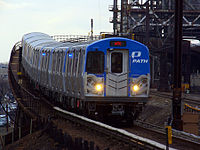
Stations 9th Street · 14th Street · 23rd Street · 33rd Street · Christopher Street · Exchange Place · Grove Street · Harrison · Hoboken · Journal Square · Newark · Newport · World Trade CenterInfrastructure Downtown Hudson Tubes · Hudson and Manhattan Railroad Powerhouse · Uptown Hudson Tubes · PATH Lift BridgeMiscellaneous Greater New York rail transit New York Rapid transit Commuter rail People mover 




New Jersey Rapid transit Port Authority Trans-HudsonCommuter rail Light rail People mover Connecticut Commuter rail Currently operating heavy rail rapid transit systems in the United States Massachusetts Bay Transportation Authority (Blue, Orange, and Red Lines) · MTA (New York City Subway and Staten Island Railway) · Port Authority Trans-Hudson · Southeastern Pennsylvania Transportation Authority (Market–Frankford and Broad Street lines) · PATCO Speedline · Baltimore Metro Subway · Washington Metro · Metropolitan Atlanta Rapid Transit Authority · Miami Metrorail · San Juan Tren Urbano · Cleveland Red Line · Chicago 'L' · Bay Area Rapid Transit · Los Angeles Metro Rail (Red and Purple Lines)
Categories:- Port Authority Trans-Hudson
- Tunnels in New Jersey
- Tunnels in New York City
- Railway lines opened in 1908
- Underground rapid transit in the United States
Wikimedia Foundation. 2010.

